Yandong Tang
Distribution-aware Forgetting Compensation for Exemplar-Free Lifelong Person Re-identification
Apr 22, 2025Abstract:Lifelong Person Re-identification (LReID) suffers from a key challenge in preserving old knowledge while adapting to new information. The existing solutions include rehearsal-based and rehearsal-free methods to address this challenge. Rehearsal-based approaches rely on knowledge distillation, continuously accumulating forgetting during the distillation process. Rehearsal-free methods insufficiently learn the distribution of each domain, leading to forgetfulness over time. To solve these issues, we propose a novel Distribution-aware Forgetting Compensation (DAFC) model that explores cross-domain shared representation learning and domain-specific distribution integration without using old exemplars or knowledge distillation. We propose a Text-driven Prompt Aggregation (TPA) that utilizes text features to enrich prompt elements and guide the prompt model to learn fine-grained representations for each instance. This can enhance the differentiation of identity information and establish the foundation for domain distribution awareness. Then, Distribution-based Awareness and Integration (DAI) is designed to capture each domain-specific distribution by a dedicated expert network and adaptively consolidate them into a shared region in high-dimensional space. In this manner, DAI can consolidate and enhance cross-domain shared representation learning while alleviating catastrophic forgetting. Furthermore, we develop a Knowledge Consolidation Mechanism (KCM) that comprises instance-level discrimination and cross-domain consistency alignment strategies to facilitate model adaptive learning of new knowledge from the current domain and promote knowledge consolidation learning between acquired domain-specific distributions, respectively. Experimental results show that our DAFC outperforms state-of-the-art methods. Our code is available at https://github.com/LiuShiBen/DAFC.
Attribute-Text Guided Forgetting Compensation for Lifelong Person Re-Identification
Sep 30, 2024Abstract:Lifelong person re-identification (LReID) aims to continuously learn from non-stationary data to match individuals in different environments. Each task is affected by variations in illumination and person-related information (such as pose and clothing), leading to task-wise domain gaps. Current LReID methods focus on task-specific knowledge and ignore intrinsic task-shared representations within domain gaps, limiting model performance. Bridging task-wise domain gaps is crucial for improving anti-forgetting and generalization capabilities, especially when accessing limited old classes during training. To address these issues, we propose a novel attribute-text guided forgetting compensation (ATFC) model, which explores text-driven global representations of identity-related information and attribute-related local representations of identity-free information for LReID. Due to the lack of paired text-image data, we design an attribute-text generator (ATG) to dynamically generate a text descriptor for each instance. We then introduce a text-guided aggregation network (TGA) to explore robust text-driven global representations for each identity and knowledge transfer. Furthermore, we propose an attribute compensation network (ACN) to investigate attribute-related local representations, which distinguish similar identities and bridge domain gaps. Finally, we develop an attribute anti-forgetting (AF) loss and knowledge transfer (KT) loss to minimize domain gaps and achieve knowledge transfer, improving model performance. Extensive experiments demonstrate that our ATFC method achieves superior performance, outperforming existing LReID methods by over 9.0$\%$/7.4$\%$ in average mAP/R-1 on the seen dataset.
CAD-Mesher: A Convenient, Accurate, Dense Mesh-based Mapping Module in SLAM for Dynamic Environments
Aug 12, 2024Abstract:Most LiDAR odometry and SLAM systems construct maps in point clouds, which are discrete and sparse when zoomed in, making them not directly suitable for navigation. Mesh maps represent a dense and continuous map format with low memory consumption, which can approximate complex structures with simple elements, attracting significant attention of researchers in recent years. However, most implementations operate under a static environment assumption. In effect, moving objects cause ghosting, potentially degrading the quality of meshing. To address these issues, we propose a plug-and-play meshing module adapting to dynamic environments, which can easily integrate with various LiDAR odometry to generally improve the pose estimation accuracy of odometry. In our meshing module, a novel two-stage coarse-to-fine dynamic removal method is designed to effectively filter dynamic objects, generating consistent, accurate, and dense mesh maps. To our best know, this is the first mesh construction method with explicit dynamic removal. Additionally, conducive to Gaussian process in mesh construction, sliding window-based keyframe aggregation and adaptive downsampling strategies are used to ensure the uniformity of point cloud. We evaluate the localization and mapping accuracy on five publicly available datasets. Both qualitative and quantitative results demonstrate the superiority of our method compared with the state-of-the-art algorithms. The code and introduction video are publicly available at https://yaepiii.github.io/CAD-Mesher/.
GMT: A Robust Global Association Model for Multi-Target Multi-Camera Tracking
Jul 01, 2024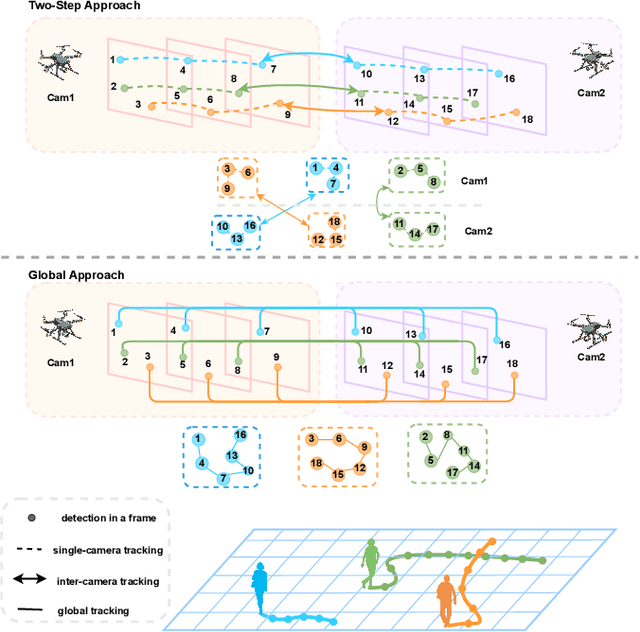


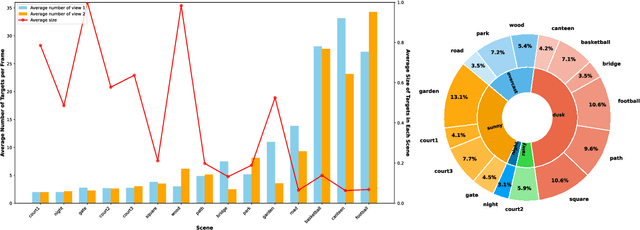
Abstract:In the task of multi-target multi-camera (MTMC) tracking of pedestrians, the data association problem is a key issue and main challenge, especially with complications arising from camera movements, lighting variations, and obstructions. However, most MTMC models adopt two-step approaches, thus heavily depending on the results of the first-step tracking in practical applications. Moreover, the same targets crossing different cameras may exhibit significant appearance variations, which further increases the difficulty of cross-camera matching. To address the aforementioned issues, we propose a global online MTMC tracking model that addresses the dependency on the first tracking stage in two-step methods and enhances cross-camera matching. Specifically, we propose a transformer-based global MTMC association module to explore target associations across different cameras and frames, generating global trajectories directly. Additionally, to integrate the appearance and spatio-temporal features of targets, we propose a feature extraction and fusion module for MTMC tracking. This module enhances feature representation and establishes correlations between the features of targets across multiple cameras. To accommodate high scene diversity and complex lighting condition variations, we have established the VisionTrack dataset, which enables the development of models that are more generalized and robust to various environments. Our model demonstrates significant improvements over comparison methods on the VisionTrack dataset and others.
Diverse Representation Embedding for Lifelong Person Re-Identification
Apr 02, 2024Abstract:Lifelong Person Re-Identification (LReID) aims to continuously learn from successive data streams, matching individuals across multiple cameras. The key challenge for LReID is how to effectively preserve old knowledge while incrementally learning new information, which is caused by task-level domain gaps and limited old task datasets. Existing methods based on CNN backbone are insufficient to explore the representation of each instance from different perspectives, limiting model performance on limited old task datasets and new task datasets. Unlike these methods, we propose a Diverse Representations Embedding (DRE) framework that first explores a pure transformer for LReID. The proposed DRE preserves old knowledge while adapting to new information based on instance-level and task-level layout. Concretely, an Adaptive Constraint Module (ACM) is proposed to implement integration and push away operations between multiple overlapping representations generated by transformer-based backbone, obtaining rich and discriminative representations for each instance to improve adaptive ability of LReID. Based on the processed diverse representations, we propose Knowledge Update (KU) and Knowledge Preservation (KP) strategies at the task-level layout by introducing the adjustment model and the learner model. KU strategy enhances the adaptive learning ability of learner models for new information under the adjustment model prior, and KP strategy preserves old knowledge operated by representation-level alignment and logit-level supervision in limited old task datasets while guaranteeing the adaptive learning information capacity of the LReID model. Compared to state-of-the-art methods, our method achieves significantly improved performance in holistic, large-scale, and occluded datasets.
Low-Tubal-Rank Tensor Recovery via Factorized Gradient Descent
Feb 03, 2024
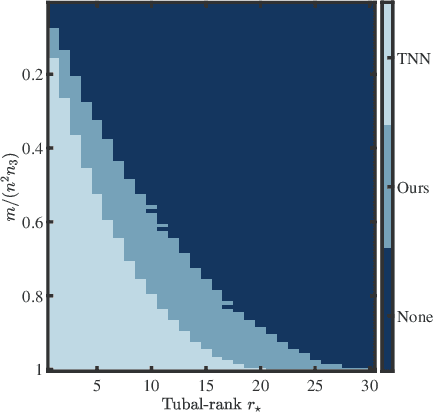


Abstract:This paper considers the problem of recovering a tensor with an underlying low-tubal-rank structure from a small number of corrupted linear measurements. Traditional approaches tackling such a problem require the computation of tensor Singular Value Decomposition (t-SVD), that is a computationally intensive process, rendering them impractical for dealing with large-scale tensors. Aim to address this challenge, we propose an efficient and effective low-tubal-rank tensor recovery method based on a factorization procedure akin to the Burer-Monteiro (BM) method. Precisely, our fundamental approach involves decomposing a large tensor into two smaller factor tensors, followed by solving the problem through factorized gradient descent (FGD). This strategy eliminates the need for t-SVD computation, thereby reducing computational costs and storage requirements. We provide rigorous theoretical analysis to ensure the convergence of FGD under both noise-free and noisy situations. Additionally, it is worth noting that our method does not require the precise estimation of the tensor tubal-rank. Even in cases where the tubal-rank is slightly overestimated, our approach continues to demonstrate robust performance. A series of experiments have been carried out to demonstrate that, as compared to other popular ones, our approach exhibits superior performance in multiple scenarios, in terms of the faster computational speed and the smaller convergence error.
Residual Denoising Diffusion Models
Aug 25, 2023



Abstract:Current diffusion-based image restoration methods feed degraded input images as conditions into the noise estimation network. However, interpreting this diffusion process is challenging since it essentially generates the target image from the noise. To establish a unified and more interpretable model for image generation and restoration, we propose residual denoising diffusion models (RDDM). In contrast to existing diffusion models (e.g., DDPM or DDIM) that focus solely on noise estimation, our RDDM predicts residuals to represent directional diffusion from the target domain to the input domain, while concurrently estimating noise to account for random perturbations in the diffusion process. The introduction of residuals allows us to redefine the forward diffusion process, wherein the target image progressively diffuses into a purely noisy image or a noise-carrying input image, thus unifying image generation and restoration. We demonstrate that our sampling process is consistent with that of DDPM and DDIM through coefficient transformation, and propose a partially path-independent generation process to better understand the reverse process. Notably, with native support for conditional inputs, our RDDM enables a generic UNet, trained with only an $\ell _1$ loss and a batch size of 1, to compete with state-of-the-art image restoration methods. We provide code and pre-trained models to encourage further exploration, application, and development of our innovative framework (https://github.com/nachifur/RDDM).
Review helps learn better: Temporal Supervised Knowledge Distillation
Jul 03, 2023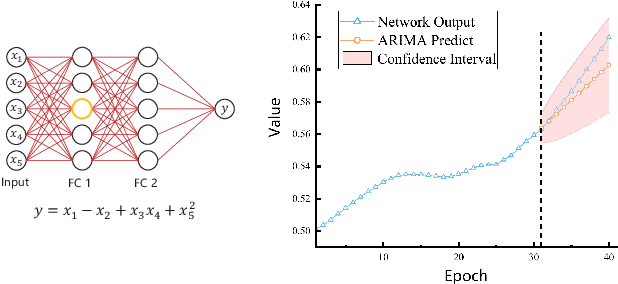
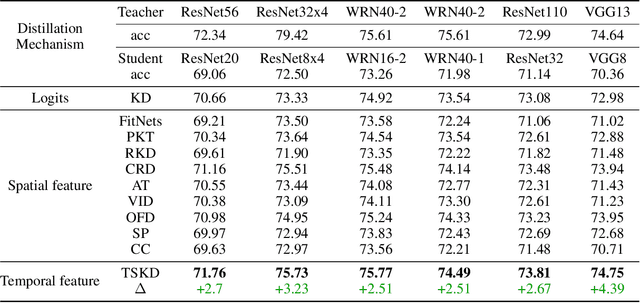


Abstract:Reviewing plays an important role when learning knowledge. The knowledge acquisition at a certain time point may be strongly inspired with the help of previous experience. Thus the knowledge growing procedure should show strong relationship along the temporal dimension. In our research, we find that during the network training, the evolution of feature map follows temporal sequence property. A proper temporal supervision may further improve the network training performance. Inspired by this observation, we design a novel knowledge distillation method. Specifically, we extract the spatiotemporal features in the different training phases of student by convolutional Long Short-term memory network (Conv-LSTM). Then, we train the student net through a dynamic target, rather than static teacher network features. This process realizes the refinement of old knowledge in student network, and utilizes them to assist current learning. Extensive experiments verify the effectiveness and advantages of our method over existing knowledge distillation methods, including various network architectures, different tasks (image classification and object detection) .
CCR: Facial Image Editing with Continuity, Consistency and Reversibility
Sep 22, 2022



Abstract:Three problems exist in sequential facial image editing: incontinuous editing, inconsistent editing, and irreversible editing. Incontinuous editing is that the current editing can not retain the previously edited attributes. Inconsistent editing is that swapping the attribute editing orders can not yield the same results. Irreversible editing means that operating on a facial image is irreversible, especially in sequential facial image editing. In this work, we put forward three concepts and corresponding definitions: editing continuity, consistency, and reversibility. Then, we propose a novel model to achieve the goal of editing continuity, consistency, and reversibility. A sufficient criterion is defined to determine whether a model is continuous, consistent, and reversible. Extensive qualitative and quantitative experimental results validate our proposed model and show that a continuous, consistent and reversible editing model has a more flexible editing function while preserving facial identity. Furthermore, we think that our proposed definitions and model will have wide and promising applications in multimedia processing. Code and data are available at https://github.com/mickoluan/CCR.
Effective Tensor Completion via Element-wise Weighted Low-rank Tensor Train with Overlapping Ket Augmentation
Sep 17, 2021



Abstract:In recent years, there have been an increasing number of applications of tensor completion based on the tensor train (TT) format because of its efficiency and effectiveness in dealing with higher-order tensor data. However, existing tensor completion methods using TT decomposition have two obvious drawbacks. One is that they only consider mode weights according to the degree of mode balance, even though some elements are recovered better in an unbalanced mode. The other is that serious blocking artifacts appear when the missing element rate is relatively large. To remedy such two issues, in this work, we propose a novel tensor completion approach via the element-wise weighted technique. Accordingly, a novel formulation for tensor completion and an effective optimization algorithm, called as tensor completion by parallel weighted matrix factorization via tensor train (TWMac-TT), is proposed. In addition, we specifically consider the recovery quality of edge elements from adjacent blocks. Different from traditional reshaping and ket augmentation, we utilize a new tensor augmentation technique called overlapping ket augmentation, which can further avoid blocking artifacts. We then conduct extensive performance evaluations on synthetic data and several real image data sets. Our experimental results demonstrate that the proposed algorithm TWMac-TT outperforms several other competing tensor completion methods.
 Add to Chrome
Add to Chrome Add to Firefox
Add to Firefox Add to Edge
Add to Edge